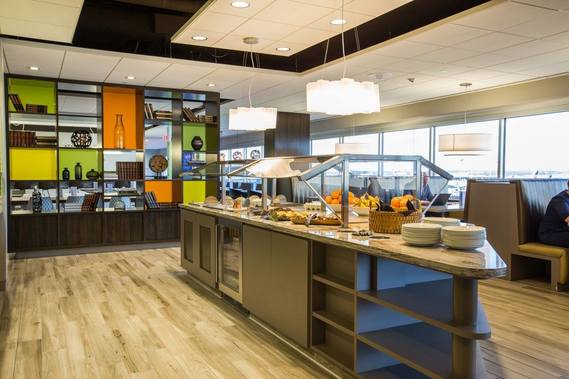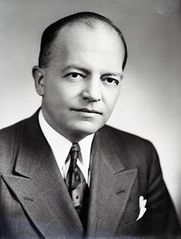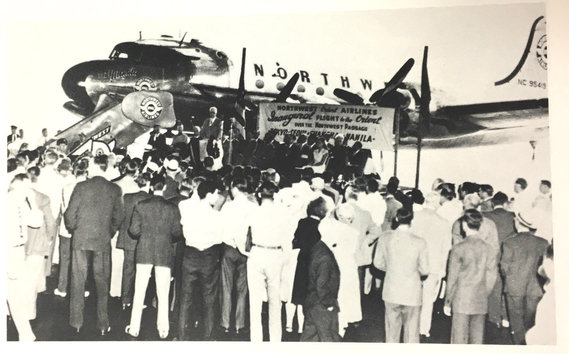|
Dramatic changes underway in restaurant options at Minneapolis-St. Paul International Airport (MSP) have led to recognition for the management team making them happen.
Airport Revenue News, a trade publication group that sponsors annual awards, named the Metropolitan Airports Commission’s (MAC) concessions team as the Best Management Team for a large airport at its annual conference this month.
The award recognized the MSP concessions team for its role in concession renovations that will lead to 30 new restaurants on top of the 50 new food and retail venues that opened over the past couple of years. The award also recognizes the day-to-day work the concessions team undertakes to keep the airport’s concession operations humming.
 “We’re very fortunate to receive such recognition, and the win also reflects the hard work of all of our concessionaires here at MSP,” said Liz Grzechowiak, assistant director of concessions and business development for the MAC (pictured). “The openings represent a major push by all of our partners, and produce big benefits for customers.”
|
 Escape Lounge at MSP's Terminal 1.
Airport Revenue News also recognized Lolli and Pops, a candy and gift shop in MSP’s Terminal 1, as the Best New Specialty Retail Concept. The store is a partnership between Pacific Gateway and St. Croix Airport Retail.
In addition, Escape Lounge in MSP’s Terminal 1 won the award for Best Passenger Services. The award recognizes a non-food, non-retail unit that excels in providing comforts and amenities to travelers. Escape Lounge is open to all passengers, regardless which airline they are flying or their airline status, and features comfortable seating, complementary food and beverages, a broad array of newspapers and magazines, and free Wi-Fi for customers. Escape Lounge is a partnership with MAG USA.
In a separate awards contest, Airport Revenue News nominates airport businesses for national awards, and readers of USA Today’s 10 Best vote on which are most deserving. Ten airport bars were nominated and MSP’s LoLo American Kitchen and Craft Bar won Best Bar in that very competitive category.
Stillwater-based LoLo emphasizes locally sourced food and drink. Its location at MSP opened on Concourse E in 2016.
 (Editor’s note:
Following is the second in a series of articles regarding how the Metropolitan
Airports Commission came into being 75 years ago, and how the commission’s
airport system has evolved over the decades.)
The Metropolitan Airports Commission didn’t come into
existence without a push by Northwest Airlines and some pulling by then-Gov.
Harold Stassen (pictured).
Aviation in the Twin Cities area in the early 1940s was
growing through commercial flights, airmail service and an ever-increasing
number of military operations. Wold-Chamberlain Field, soon to get a new name,
was already a major flight-training center for the military.
The idea of making the Twin Cities region a leading aviation
hub had been discussed for years. Minnesota Gov. Harold Stassen spoke once of
watching planes land at St. Paul’s Holman Field in the 1930s, and then 15
minutes later take off for Wold-Chamberlain less than 12 miles away.
“I recognized how
illogical that was from the stand point of air travel,” Stassen said. “So when
I was elected governor in 1938 I decided there ought to be one major municipal
airport for the Twin Cities area and that it should be under a special
municipal airport commission.”
|
 The terminal building at Wold-Chamberlain Field, mid-1940s.
In the same era, Northwest began using its influence to push for a single Twin Cities airfield.
In 1941, the St. Paul City Council met to discuss Northwest’s plan to withdraw from Holman Field that fall and serve the Twin Cities through Wold-Chamberlain only. As Northwest ended all service at Holman Field in November 1941, the annual passenger count at Wold-Chamberlain was 114,000 and projected to increase to 800,000 after the war.
In January of 1943, the Minneapolis Tribune ran a story with the headline “NWA Chief Proposes Gigantic Expansion of Minneapolis Airport.”
Croil Hunter, then the president of Northwest Airlines, said the expansion of Wold-Chamberlain was necessary to satisfy existing commercial and military aviation needs.
The growth plan would also establish the airport as a “super airdrome” for international air commerce, he said.
Holman Field in St. Paul, he said, “will qualify in the post-war era as a busy port for handling flying freight cargoes and much local air commerce.”
Believing that the Twin Cities had missed becoming a big hub for rail traffic, civic leaders were determined not to miss the boom in aviation and airline service for lack of a major airport.
 A scene from the first meeting of the nine-member Metropolitan Airports Commission in 1943. Initially, the commission had four members each from Minneapolis and St. Paul, and a chair appointed by the governor. Lewis Castle of Duluth, the first chairman, is at center with the paper.
That push required concentrated air service at one location, a political need for an airfield equidistant from downtowns of both Minneapolis and St. Paul, and enough room for expansion to fulfill the vision of an international hub.
By 1943, the idea had gained momentum. In Stassen’s plan, the commission owning and operating the airport would derive its authority from the state – not from a municipality, as is common in many cities around the United States.
Another motivation for a state-authorized airport was better access to the government funds needed to build a large facility. The initial act establishing the MAC allowed the state to issue bonds for airports, and gave the governor $1 million for the Minnesota Metropolitan Airports Fund to be spent at airports statewide.
Stassen said he was looking forward to the day when the Twin Cities would be a jumping off point for air travel to “the Orient and link to East Asia flights and South America.”
As the 1943 Minnesota legislative session began, representatives of Minneapolis and St. Paul met with Stassen to go over proposed legislation to set up a joint “MSP airways commission.”
At the time, Wold-Chamberlain Field was controlled by the Minneapolis Park Board, and the city of St. Paul controlled Holman Field. The new law would convert control of those facilities to the new commission.
The Minneapolis Tribune reported that the commission that Stassen envisioned would work in harmony on a post-war airport program for the Twin Cities and have powers to include “acquiring property, build and equip airports, take over existing airports and hire a manager for them.”
Stassen’s idea for a commission also had the support of Northwest Airlines.
 A crowd gathered at MSP/Wold-Chamberlain for Northwest's inagural flight to Japan and other destinations in Asia, July 1947.
As the airports commission bill moved through the State Capitol and was approved by the Senate, the Minneapolis Tribune called it “the most important legislation of the session and will enable Minnesota to take front rank in the postwar air transport picture.”
The legislation establishing the MAC won final approval on April 19, 1943 and the law took effect on July 6, 1943.
Despite the passage by the Legislature, the MAC’s early days were not drama-free. The same month that the MAC came into existence, Gov. Stassen – the MAC’s key supporter -- resigned his office to serve as a Naval officer in WW II.
And days before the Minneapolis Park Board was to relinquish control of Wold-Chamberlain to the MAC, lawsuits were filed challenging the move. The lawsuits questioned the constitutionality of portions of the law that established the MAC.
Ultimately, the state and the MAC prevailed, and in August 1944, the MAC officially assumed control of Wold-Chamberlain and Holman Field.
Northwest continued to grow at Wold-Chamberlain through the 1940s, but the airport’s biggest user remained the military. As late as 1947, military flights still made up almost half the aircraft operations at Wold-Chamberlain.
After the war, scheduled commercial service to Tokyo, Seoul, Shanghai and Manila began on July 15, 1947 on a 50-passenger Northwest DC-4.
To reflect the airport’s new ties to destinations overseas, the airport’s name was changed to Minneapolis-St. Paul International Airport/Wold-Chamberlain Field in 1948.
Next month: What a relief – the MAC moves to establish reliever airports around the Twin Cities.
Sources of information: “America’s North Coast Gateway, Minneapolis-St. Paul International Airport,” Karl Bremer, 1993.
Minneapolis Tribune articles from the 1930s and 1940s.
Documents from the Minnesota Historical Society Collection.
On Wednesday, April 4, the Metropolitan Airports Commission
will hold a public
hearing on plans to address facility needs at Lake Elmo Airport over the
next 20 years.
The airport’s long-term comprehensive plan (LTCP) is a road
map to guide future airport development and address issues that include failing
infrastructure, enhanced airfield safety and improved operational efficiency.
The events on April 4 will take place at Oak-Land Middle
School Auditorium, 820 Manning Ave. N., Lake Elmo MN 55042, and include an open
house starting at 6 p.m., a presentation at 6:30 p.m. and the public hearing at
7 p.m.
Board Meetings
Business Opportunities
Career Opportunities
General Aviation Airport Information
MSP Aircraft Noise Information
MSP Airport
|